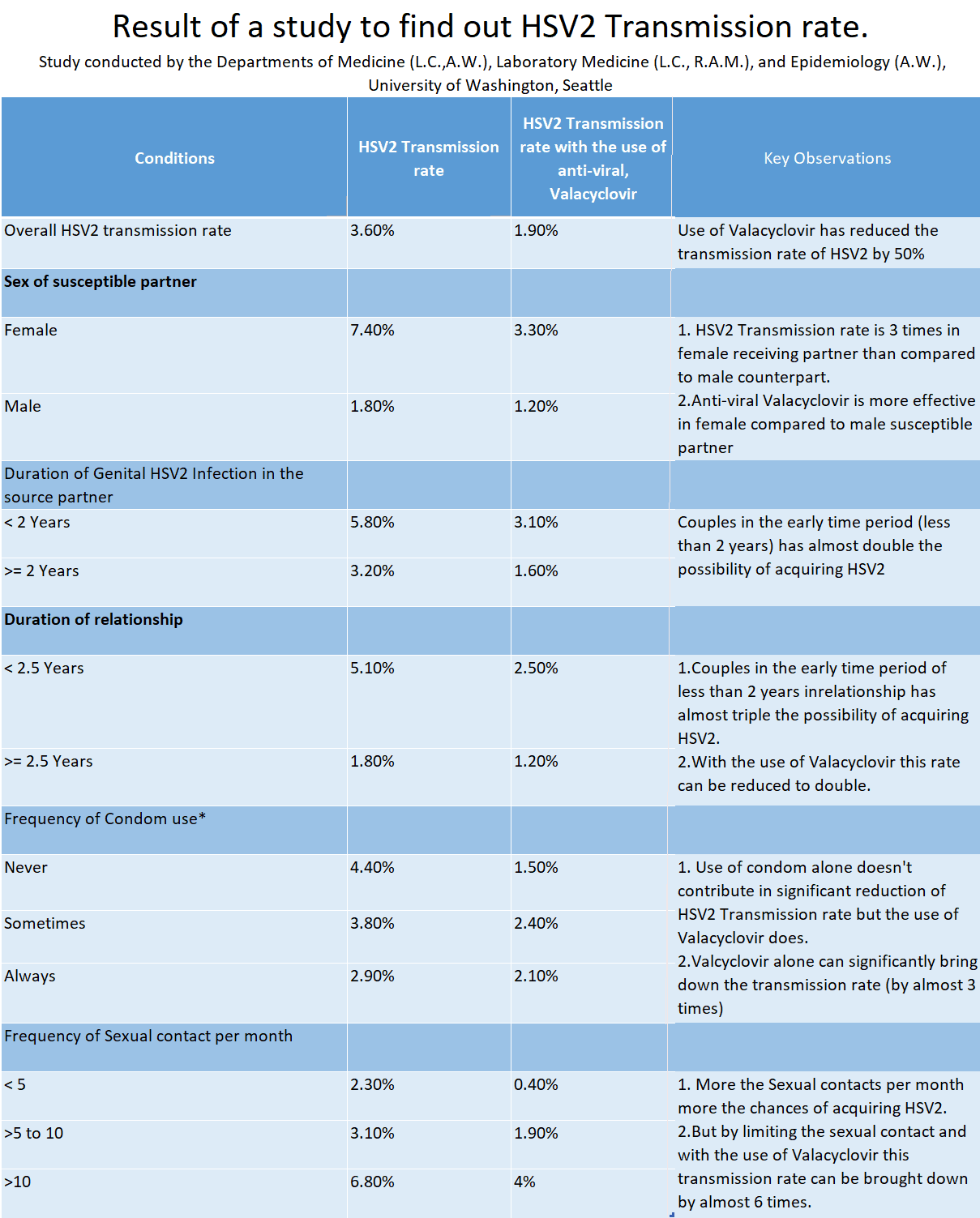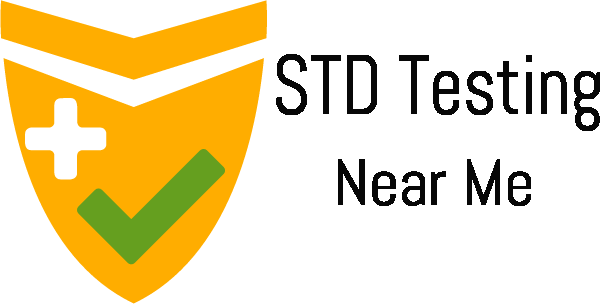
Overall, herpes (HSV2) transmission rate without any medication is 3.6%. However, the transmission rate is 1.9% in case the susceptible partner takes valacyclovir (an antiviral drug).
In a study conducted by the Departments of Medicine (L.C.,A.W.), Laboratory Medicine (L.C., R.A.M.), and Epidemiology (A.W.), University of Washington, Seattle with 1400 individuals it was confirmed that people with symptomatic herpes who take valacyclovir are almost 50% less likely to transmit the virus to others than non-medicated people with herpes.
Although, the overall rate is between 1.9 to 3.6%. The transmission rate of herpes varies and it depends on many factors such as the gender or receiver, duration of the relationship, frequency of sexual contacts, etc.
Get tested for STD: At the STD testing center near you.
Let us consider each and every factor affecting the rate of herpes spread and observe the rate itself in that case.
1.Sex of the susceptible partner
In the research, it has been found out that the rate of spread of herpes (hsv2) is significantly different in particular gender
- If the susceptible partner is female there is a 7.44% chance of acquiring the HSV2 from the infected male partner.
- On the contrary, the chances of susceptible male partner acquiring the HSV2 is just 1.8% compared to his infected female counterpart
Conclusion: HSV2 transmission rate is almost Three times incase of female receivers or female susceptible partners as compared to male susceptible partners.
2. Duration of HSV2 in the source partner.
It is observed in the research that the duration for which the source partner (regardless of its gender) affects the rate of transmission.
If the source partner has HSV2 for less than 2 years then the chances for transmission are 5.8% as compared to if the source partner has the HSV2 for more than 2 years, the transmission rate dips down to 3.2%.
Conclusion: Older the duration of HSV2 in the source partner, the lesser the chances of transmission to the susceptible partner.
Also read: How Herpes transmits through non sexually & its associated myths
3. Duration of relationship
The duration is an obvious factor as the transmission rate is calculated on a “per year” basis. In the study, the following things have been observed.
- If the duration of the relationship is less than 2.5 years the chances of herpes (HSV2) transmission is 5.1%.
- If the duration of the relationship more than 2.5 years the chances of transmission reduce by almost 3 times, it’s just 1.8%
Conclusion: The chances of HSV2 transmission are almost triple in the first 2.5 years of the relationship.
Also read: Difference between Herpes (STD) vs Genital grains vs pimples (or Ingrown hair cyst)
4. Frequency of the use of condoms
This one is an easy guess, as we know that condom reduces the chances of contracting STDs, it is no different in case of protection against the HSV2. The frequency of the use of condoms while having sex is directly proportional to the rate of the transmission of HSV2.
- It has been observed that the transmission rate of HSV2 in the person who has never used a condom is 4.4%.
- The transmission rate of HSV2 in the person who is not frequent in using the condom is 3.8%
- The transmission rate of HSV2 in the person who nearly always uses the condom is 2.9%
Conclusion: The frequent use of condoms while having sex, reduces the chances of transmission of HSV2 in the susceptible partner.
Also read : Herpes symptoms, testing, and treatment
5. Number of Sexual contacts per month
Herpes HSV2 is a sexually transmitted disease, so the frequency of sexual contact among couples is bound to play a role in the transmission of HSV2.
In the study, the following correlation was observed between HSV2 transmission and Sexual contacts.
- Couples having sexual contact less than 5 times per month have the chance of 2.3% of acquiring HSV2.
- The ones having sexual contact between 5 to 10 times per month have the chance of 3.1% of acquiring HSV2.
- While the couples indulged in more than 10 sexual contacts per month has the highest chance of 6.8% of acquiring the HSV2.
Conclusion: It is observed that the couples having 10 sexual contacts per month has 3 times the chances of HSV2 compared to the couples having 5 sexual contacts per month. Thus, the higher frequency of sexual contact increases the chances of acquiring HSV2 in couples.
Download the Detailed table stating Herpes (HSV2) transmission rate here
What can be done to prevent or reduce the transmission of HSV2?
- Study data shows that people with symptomatic herpes who take valacyclovir are almost 50% less likely to transmit the virus to others than non-medicated people with herpes.
- In the above study, the HSV-2 acquisition rate was reduced from 3.6% to 1.9% using valacyclovir treatment.
- Herpes viruses are most likely to be transmitted during an outbreak, so it’s better to not have sex during this time.
- Herpes can also be passed on to others in symptom-free phases, though. This risk can be reduced considerably by using condoms.
- Getting your susceptible partner tested for Herpes regularly. Here is a $10 discount coupon from our side.
References
2.NCBI Herpes research
3. Research Gate study on Herpes : https://www.researchgate.net/figure/Covariate-Analyses-of-Factors-Influencing-the-Transmission-of-Genital-Herpes_tbl2_8937692


